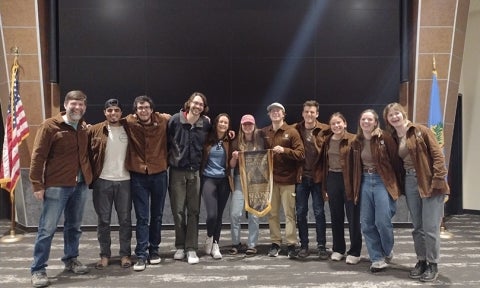Cal Poly Soil Judging Team Wins Second Place at National Competition
Contact: AnnMarie Cornejo
805-756-2427; ancornej@calpoly.edu
SAN LUIS OBISPO — A flight delay and missed day of practice didn’t stop the Cal Poly Soil Judging Team from beating out 21 other teams to take second place at the National Collegiate Soils Contest at Oklahoma State University.

The competition held March 26-31 in Woodward, Oklahoma, included 23 teams from colleges and universities throughout the nation. The 10-person Cal Poly team advanced to the competition after a first-place finish at the regional contest held in November 2022 in Sonora, California.
“I have been to three contests, and I have to say it is one of the most fun, exciting and unique ways to learn,” said Andrew Litto, a fourth-year environmental earth and soil sciences major. “Soil is so dynamic and diverse, and traveling to see new soils is truly a privilege. At this contest, I was able to use what I have learned in my college experience and represent our university well.”
The Cal Poly team, coached by Professor Gordon Rees of the Natural Resources and Environmental Sciences Department, is comprised of students majoring in environmental earth and soil sciences and environmental management and protection. The team was narrowly edged out of first place by the University of Maryland with a point margin of 2428-2422.
Each year the National Collegiate Soils Contest is held at different host institutions throughout the nation to expose students to different terrains. Teams must correctly identify, evaluate, classify and describe the four soil profiles at various soil pits as a professional soil scientist would, under a time constraint.
“The competition allows students to practice the technical skills they have learned in their classes, while interacting with new and diverse soils,” Rees said. “I am extremely proud of their achievements.”

Students only had three days in northwestern Oklahoma to familiarize themselves with the area’s soils prior to the two-day competition. A flight delay led to the team miss their first day of practice, but the team started working as soon as they arrived.
In addition to earning second place as a team, fourth-year environmental earth and soil sciences major Lauren Morris placed fifth as an individual, and the team ranked fifth in the group judging category. Fourth-year environmental earth and soil sciences major Miguel Ramos placed 11th as an individual competitor, and Litto placed 22nd. There were 92 total individuals competing.
“I am so grateful to have been able to participate in the national contests for the past two years, as soil judging has helped me grow immensely as a soil scientist and created some of my best friends and memories,” Morris said. “I am so proud of how the team has grown over the past two years under Dr. Rees. All of the individuals on the team have put in a lot of hard work, and I couldn’t be prouder of our second-place finish.”
Cal Poly’s soil judging team has a longstanding tradition of excellence dating back more than 50 years.
“Many of our soil science alums fondly remember attending competitions across the state and the country, showcasing Cal Poly’s Learn by Doing spirit and making lifelong friends in the process,” Rees said. “The team is proud to continue to represent Cal Poly’s and uphold this legacy of success.”
About Cal Poly’s College of Agriculture, Food and Environmental Sciences
Cal Poly is a nationally ranked, comprehensive polytechnic university. The university’s College of Agriculture, Food and Environmental Sciences is comprised of expert faculty members who take pride in their ability to transform academically motivated students into innovative professionals ready to solve the complex challenges associated with feeding the world in sustainable ways. Students have access to state-of-the-art laboratories, including ranch land, orchards, vineyards and forests, all of which provide the basis for Cal Poly’s Learn by Doing methodology. It is the fifth-largest college of agriculture in the country, with 4,000 undergraduate students. Visit cafes.calpoly.edu for more information.



